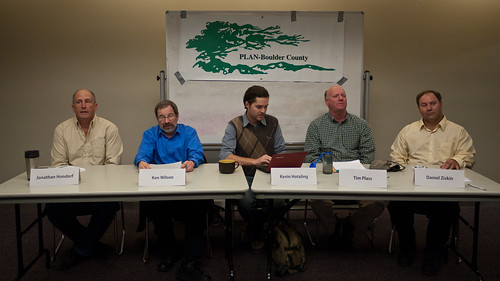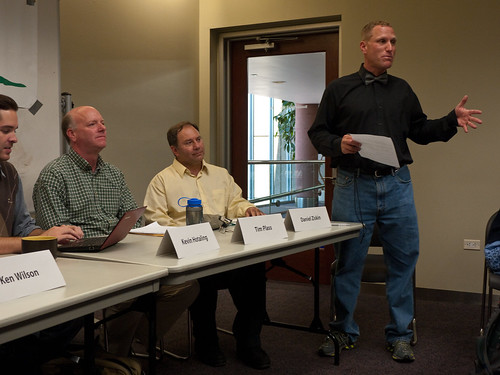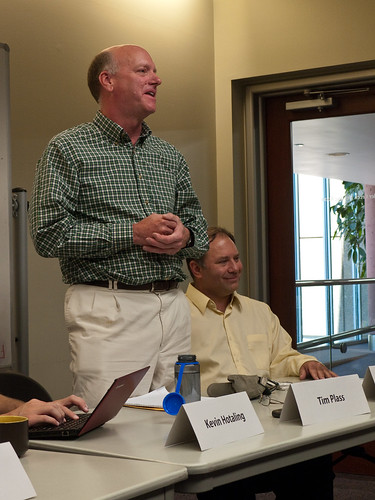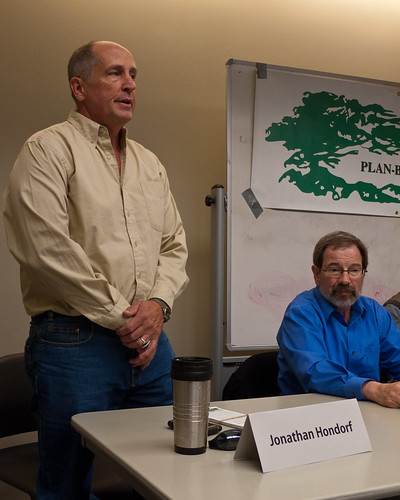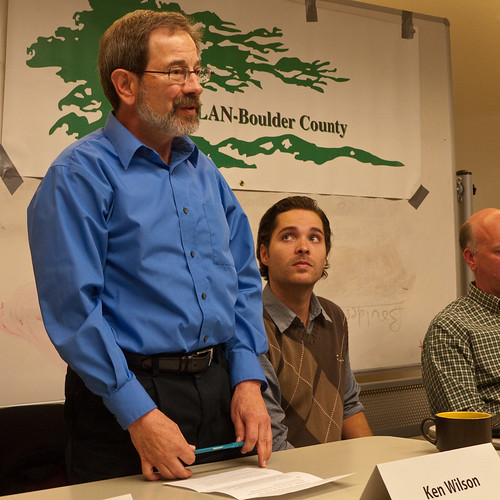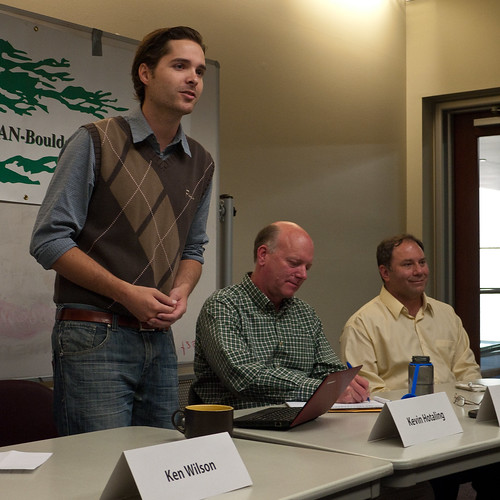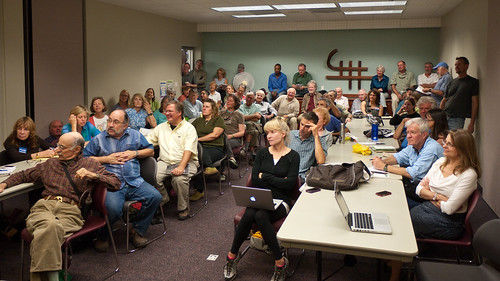Friday September 9th, PLAN-Boulder County held the first of three City Council candidate fora at the Boulder Public Library. The room was packed, with people standing in the back, listening to Tim Plass, Daniel Ziskin, Jonathan Hondorf, Ken Wilson and Kevin Hotaling define their platforms. John Tayer acted as moderator. Each candidate was first allowed to introduce themselves for 90 seconds. This was followed by about an hour’s worth of pre-selected questions from PLAN-Boulder, and the last half hour was dedicated to audience questions vetted by Alan Boles.
Tim Plass currently serves on the Planning Board, and prior to that served on the Landmarks Board. He said he’s running in part because both Susan Osborne and Crystal Gray are bowing out of the race. He’s very excited about the Boulder Light and Power initiatives (2B/2C) and wants to be a part of it. Loves Boulder, wants to help make sure we maintain our open space policies and keep the built environment high quality. Wants to keep our local economy strong.
Daniel Ziskin described himself as a physicist and earth scientist, and related the story of his awakening as an environmentalist while mourning the loss of an urban woodland back east.
Jonathan Hondorf, a local developer, wants to focus on our energy, environment and economy. He praised the city’s past bold policy actions, and urged us not to retreat into the status quo.
Ken Wilson, the only incumbent candidate in the group, was elected to council 4 years ago, and became deputy mayor 2 years ago, with support from Mayor Susan Osborne. He said he feels like he’s only now really gotten up to speed with the many complex issues facing the city, and wants to stick around for another term to apply that understanding. He’s previously served on the Water Resources Advisory Board, and has a technical background in electrical engineering and biology. He said the city has some very aggressive goals — and that’s good. He wants to keep it up.
Kevin Hotaling appeared to be the youngest member of the panel, by a solid 10-20 years. He said he’s a web designer, and also works as a consultant to people all over the country producing biodiesel. He said he values living a sustainable lifestyle, and is proud that the city makes this possible. He believes that the city has seen a decade of controversies and divisive politics, driven by pandering to special interests, and that it’s time to bring people back together.
PLAN-Boulder County Questions
Q: What should we do to reduce our greenhouse gas emissions?
Daniel Ziskin suggested that perhaps we could target our home energy efficiency audits by taking an aerial photograph of the city shortly after a new snowfall, to see which roofs the snow has melted off most quickly — those are the ones that need more attic insulation. He said we should improve the efficiency of our neighborhoods.
Jonathan Hondorf said we need to reduce energy demand, and not just from residences, as commercial and industrial customers actually use 75% of the electricity in Boulder. We need to work on transportation challenges, getting people out of single occupancy vehicles. Need to create incentives for people to do the right (low carbon) thing in their transportation choices.
Ken Wilson recounted working on SmartRegs with the Boulder Area Rental Housing Association, helping make sure that it was a negotiation, instead of just something that got forced upon landlords. Since commercial/industrial energy use is 3 times as great as residential, it will be even more important to get it right. We’ve learned from the residential program and negotiation process, and can do it well. Efficiency is the biggest target to aim for in energy.
Q: What do you think about the possibility of a commercial SmartRegs program?
Kevin Hotaling questioned whether these kinds of regulations really end up changing behavior, or are they just a source of yet more bureaucracy? He doesn’t believe that they work in general. Not in favor of a commercial SmartRegs program.
Tim Plass disagreed with Hotaling. He said he believes that good regulation is possible, and supports SmartRegs. He reiterated the fact that the commercial sector is the majority of our energy use, so it has to be tackled if we really want to reduce GHG emissions. However, as with the residential, we have to find an ordinance that works. Residential SmartRegs was a good learning experience. We need to communicate well with businesses, and find money up front to help finance the investment in efficiency. As with the residential program, there are lots of split incentives between landlords and tenants that need to be addressed for efficiency to be improved.
Daniel Ziskin recalled that when serving on the Environmental Advisory Board (prior to the SmartRegs program’s development) he put a property up for rent. The safety inspection for the rental license was onerous, but there was nothing in the way of an energy efficiency inspection, which he found shocking. He mentioned it to the board that it was a big missing piece in the rental process. Ziskin stressed that he wasn’t taking credit for any of the ensuing hard work, just that he put the idea out there way back when.
Ken Wilson favored more voluntary measures, and mentioned a program called Ten For Change, in which businesses voluntarily sign up to reduce their energy usage by 10% over the course of a year.
Jonathan Hondorf felt that businesses are struggling and shouldn’t be burdened with more requirements right now. Given the right environment people will voluntarily come forward to do the right thing with respect to energy efficiency.
Q: What is your position on the Boulder Light and Power initiatives (2B/2C)?
Jonathan Hondorf was involved in the citizen’s modeling effort, looking at technical and financial feasibility. He is enthusiastically supportive of the ballot measures. He emphasized the absolute need to get away from fossil fuels, and the scale of the global problems that result from GHG emissions. However, he also stressed that whatever our solution is, it must also work for businesses, as they are the majority of our energy use. He was confident that the ballot measures would pass, and that the city would move ahead.
Ken Wilson said he’d spent many years working at Bell Labs, and with other utilities and telecommunications companies over the years. He does not believe that a Boulder municipal utility will work, expects Xcel to drag the process out, and make it as expensive as possible for the city. Would rather spend all that time working on “real” renewable energy. Stated that other municipal utilities aren’t doing the kinds of things that we want to do with ours.
Kevin Hotaling asked where are we going to get the most tangible results in the least amount of time, and suggested that the energy business environment is more complex than it seems. He said he wad worked on a financial analysis with others at CU that showed it wouldn’t work, and expects the municipal utility to eventually declare bankruptcy if it is formed.
Tim Plass put himself out there as a strong supporter of 2B/2C. He said that he had been to many, many learning sessions, and believes that the extensive analysis done by the city shows that it’s feasible both technically and financially. Moreover, voting yes in November gives us the full range of options to explore and improves our bargaining position with Xcel.
Daniel Zisken was also a strong proponent of municipalization, and agreed with Tim Plass. He founded an organization called Ratepayers United of Colorado. He has intervened at the Colorado Public Utilities Commission, and believes that a swift transition to renewables is not only the right thing to do with respect to climate change, but that it is also in the best interest of the ratepayers. Xcel has invested billions in coal plants, and is incapable as an institution of being supportive of wind and solar power at scale.
Kevin Hotaling responded directly to Ziskin‘s enthusiastic support by claiming that nobody had projected the revenues for the putative municipal utility, at which point Jonathan Hondorf broke in to give him a smackdown. Hondorf claimed that as a member of the financial modeling team he could personally attest to the fact that they did project revenues, and the municipal utility comes out well both technically and financially. He further noted that the vote in November isn’t an either/or decision — we’re not voting on whether to create a muni, we’re voting on whether we even want to seriously consider it as one of the options on the table.
Q: What are some examples of the best and worst new land developments in Boulder in recent years? Describe why you think they are good/bad.
Ken Wilson identified Washington Village as an example of both the good and the bad. The project was very controversial, and resulted in a lot of conflict in the neighborhood, lost time, and lost money for the developer. He said people are uneasy with increases in density, and that we especially need to do a better job of integrating new and dense developments with alternative transportation infrastructure. In the end though, he feels that Washington Village has worked out great.
Tim Plass felt that the Holiday Neighborhood on North Broadway has clearly worked. It’s got some increased density, aligned with a transit corridor. It’s animated NoBo, and made it into a destination. He thought that the city did a good job of facilitating the process by buying up the old theater site. Plass was not a fan of the Peloton. Felt it was too monolithic, isolated and has also turned out not to be financially successful for the developer. On Washington Village, he said that regardless of the ultimate outcome, the process was clearly a disaster — long, drawn out, and stressful for everyone involved. He suggested that involving neighborhoods in the planning process from the beginning could avoid a lot of that kind of pain in the future.
Daniel Zisken focused on the 29th Street Mall. He liked that it was a brownfield re-development, and that it’s easily accessed via the Hop. He disliked the fact that it was all chain stores, surrounded by a “sea of asphalt”, and that the development as a whole seems very car oriented. He said he believes that there are higher value uses for that land, and that he’s sad the city ceded so much power to the developers, and essentially let them build whatever they wanted.
Jonathan Hondorf agreed with Plass about NoBo and the Holiday Neighborhood being a good example of modestly higher density development that’s still livable and interesting. He said he was concerned about the Transit Village Area Plan, and questioned whether density is necessarily the answer to our housing problems. He suggested that increasing density was not going to be good for families that want to live in Boulder. He wants to see any new density made accessible and convenient without relying on cars. Said we have a lot of power via the ordinances that control our built environment, and held up SmartRegs as an example of regulation that’s working.
Q: What’s your take on the Area III Planning Reserve?
Kevin Hotaling suggested that it was inappropriate to pit historic preservation against development, and thought that by developing outlying areas, like the planning reserve, we might be able to relieve some of the pressure on our historic districts. He said he believed we should allow small scale development on open space, and that we really don’t need to buy up every last acre of land in the county.
Daniel Ziskin thought that there’s been enough discussion of Area III for the time being. Now is clearly not the time to develop it. We should set it aside for another 5-10 years, and revisit the question then. More importantly, he felt that we need to change the way that development is debated. He would rather see people have to demonstrate the value of their planned development, instead of the city having to defend the value of the open space.
Ken Wilson said he’d support changing the development review process to include just the Planning Board and City Council (two body review), instead of involving the outlying communities and the county as well (four body review). He questioned the need to get permission from other cities for our own planning decisions. Wilson also mentioned concerns that we may lose Naropa University, if a suitable site for them to grow and consolidate their campus isn’t available.
Jonathan Hondorf seemed confident that Area III will never be developed, as open space preservation is very entrenched at this point. He supported the 4-body review process, saying that there’s an interaction between us and the other communities around us, and that our decisions do affect them.
Tim Plass said that nearby land is a very limited resource, and that he supports the 4-body review process. He noted that green field development can never really be undone, so decisions need to be made very carefully.
Q: Boulder’s population today is about 100,000. What’s the ideal number?
Tim Plass said it’s impossible to come up with an absolute number, and that at any population, the quality of life will depend strongly on the built environment. At the same time, he said he doesn’t want Boulder to become a “big city,” and would rather we remain a town in character. Additional population needs to be accommodated within our existing geographic boundaries by modestly increasing density, and building more small, efficient units. He was not in favor of increasing the 55′ height limit.
Jonathan Hondorf was also skeptical than anyone could really come up with the right number. He agreed with Plass that we should keep our open space boundaries and height limit intact indefinitely, and allow those to define our urban form. He didn’t want to risk making people feel like “rats in a maze.” He suggested that increasing density does decrease the quality of life, and said we need to prioritize the creation of more affordable housing within our city, lest we become a kind of boutique community, inaccessible to mere mortals.
Daniel Ziskin said that rather than focusing on managing our population per se we should work on reducing the number of in/out commuting trips, as it’s not just the number of people, but what their daily activity pattern is that affects our quality of life.
Q: What do you think about the city’s recent affordable housing report?
Daniel Zisken felt that having a cap on equity in affordable housing was a boon to buyers, but that it doesn’t help people bootstrap themselves out of poverty — once you’ve bought into affordable housing, that’s pretty much where you’ll stay, as the value of your home cannot increase at the same rate as other properties in the city. He felt that the allowable equity increase should be better indexed to the cost of living, and wondered whether it might not be possible for the city affordable housing program to somehow kick in money directly to subsidize the purchase of market price homes instead.
Ken Wilson said he thought the city was doing pretty well with its affordable housing goals, so far as they go, but that we were doing a poor job of creating “workforce housing” that can appeal to young families who currently get priced out of the local market, and end up exiled to Broomfield and the L-burbs. We’ve got options for the top and the bottom of the income spectrum; now we need to work on filling in the middle. At the same time, he noted that these cost of living issues are intimately tied up with people’s transportation decisions, and wondered if we might not be able to solve some of this problem by giving people cheaper, more convenient transit options.
Q: What’s the right balance between transportation and land use planning?
Kevin Hotaling said he felt that those with modest incomes were being hurt by our affordable housing policies, driving their costs of living up. He suggested that we might consider some “tentpole density” scattered in limited areas around the city, to help create some housing supply and thus reduce prices.
Tim Plass said he thought we had a good affordable housing program, but that of course it could be made better, and more efficient. He said we need to keep our inclusionary zoning (PDF) ordinance, but find a broader base of funding for the program as a whole. He suggested that eventually, we would probably have to bring this back to the voters to decide where the money would come from, and how much there would be.
Jonathan Hondorf pointed out that as it is today, the creation of affordable housing units is dependent on new development for funding, and most developers choose to do cash-in-lieu (paying the city instead of making some of their units permanently affordable). With slow or declining rates of development in town, we can’t be simultaneously anti-growth and supportive of affordable housing. Hondorf also questioned the need to subsidize affordable housing in town for so-called middle income households earning $90-$100k/year.
Q: What should we do about the commute hour congestion on US-36?
Jonathan Hondorf pointed out that we’ve been talking about getting rail service between Denver and Boulder for close to 40 years, and we thought it was too expensive way back when at $45 million. He said we need to build better regional transit service, and align RTDs financial incentives such that as the service is used more, they can respond by providing more and better service. He decried the recent reductions in service as being counterproductive for the region.
Kevin Hotaling said that the creation of more density locally would alleviate many of these transportation problems.
Ken Wilson said he thinks that transit along the US-36 corridor is a huge issue. It needs to work much better. Density can incentivize transit use, but it doesn’t work well if people are still using their cars to get to transit. He also mentioned the need to figure out how to make rail viable without making a mess of the county by developing all along the rail line.
Q: Should the city keep trying to shift people away from using cars?
Ken Wilson was enthusiastically in favor of continuing efforts to get people to bike, walk and use transit. For many years he commuted by bus into downtown Denver. He wondered if we might not be able to get better transit education into the Boulder Valley School District.
Tim Plass emphasized the need to make it convenient not to drive, with great bike and pedestrian environments and connections. He voiced his support for a community-wide Eco-pass program, and said that we really need to work on getting the commuter rail line built, that we’d regret not doing it later.
Daniel Ziskin didn’t want any coercive anti-car measures, and also emphasized making biking and walking and transit much easier to use. He came out against the train, and suggested instead that we make the bus work better, as it’s so much cheaper. In particular he was supportive of implementing the planned Bus Rapid Transit corridor along 36.
Q: Should the city ban plastic shopping bags, or require a fee to provide them?
Kevin Hotaling was strongly opposed to a ban on plastic bags, and said he didn’t think it would work. He suggested that this type of regulation can only really work when the regulated entities are large and few, and that it would be a mess with the large number of retailers and consumers that would be affected. He said that instead we should use voluntary measures, and stay away from heavy handed government.
Daniel Ziskin highlighted his activity with Better Bags Colorado, attempting to get a tax imposed on single use bags, but new tax can’t be imposed without appeal to the voters, because of TABOR. He said that it’s clearly a blind spot, as someone somewhere is already paying for the bags — we just need to make that cost transparent to the consumer.
Jonathan Hondorf suggested looking at a deposit system, like the ones we’ve used successfully for glass bottles and cans to incentivize re-use and recycling.
Ken Wilson said he had hoped that we would get functional biodegradable bags by now, and that he was disappointed that it hadn’t happened. He agreed that some kind of deposit system would be good, and that he’d really like to see us move away from using so much disposable plastic. He said that “voluntary” programs just don’t work on issues like this — the default behaviors are just too strongly ingrained.
Tim Plass noted that lots of young people had been speaking to council about the issue, and that we ought to do something, but it’s not clear what will really work.
Q: Who are your political heroes, and why?
Tim Plass: Locally, Susan Osborne (Boulder’s current mayor). She’s great at bringing people together, and figuring out a solution that works.
Jonathan Hondorf: Senator Rollie Heath for taking the incredible position that we should raise taxes to fund education!
Ken Wilson: Also Senator Heath, for his ability to work both sides of the aisle.
Kevin Hotaling: Not really a politician, but Dr. Paul Farmer, a Harvard MD who has dedicated his life to public health in Haiti, now working in Rwanda.
Daniel Ziskin: This isn’t likely to be a popular response… but president Obama, for having the courage to take a leap of faith in the debate over extending the Bush tax cuts. He wasn’t in favor of them, but attempted to bridge the gap with Republicans by supporting them. Unfortunately, it didn’t work.
Questions from the audience
Q: Would you support discontinuing mandatory parking minimums?
Jonathan Hondorf said that if we’re going to change our transportation systems, we have to change our parking policies. He was supportive of reducing parking requirements.
Ken Wilson was philosophically in agreement, but pointed out the need to deal with overflow and the potential effects on adjacent neighborhoods. He pointed out that CU cut down on their parking, and saw a tremendous increase in bike usage by students, so maybe it can work elsewhere too.
Kevin Hotaling said that a big reason he moved to Boulder was so he could get rid of his car, but not everyone is willing to do that. You can’t force people to do it. On a related note, he suggested that we might consider integrating the fleet of city vehicles into a carshare program, as the city of Philadelphia has done.
Daniel Ziskin mentioned that he has served on the board of the local eGo Carshare, and worked with developers trying to get a few dedicated carshare parking spots on 28th, and Boulder One Plaza.
Q: What about creating more affordable rental properties?
Kevin Hotaling noted that even excluding the students the median age in Boulder is 35, and that most of that half of the city’s population rents. He said that building rental properties doesn’t seem to be a possibility that’s open to developers, and we need more of it. By preventing larger rental properties from being created, we restrict the rental market and drive prices up, hurting our younger residents.
Tim Plass said that a large portion of the affordable housing program is rental units, and that owning your own home really isn’t the right option for a lot of people. Plass again pointed out that we need a better funding stream to support our affordable housing goals, especially on the rental side.
Daniel Ziskin pointed out that lots of homes have extra space already (finished basements, carriage houses, etc), and added that we should make it quick and easy to develop those spaces and rent them out legally. This would both help the renter market, and give homeowners some needed revenues.
Q: The city is requesting $49 million in bonds to finance deferred maintenance. Is this a good idea? Shouldn’t we have just budgeted for it along the way?
Tim Plass responded that certainly it would have been better that way, but we are where we are today, and this infrastructure needs work. He’s in favor of ballot measure 2A.
Q: Should we have additional restrictions on nighttime and off-trail access to our open space?
Daniel Ziskin said we were asking for trouble letting people wander around in the dark, that it was an issue of personal safety and that we would eventually get in trouble for it. He also said he thought it was bad for wildlife. He was also in favor of more restricted off-trail access.
Jonathan Hondorf noted that open space is also used by non-Boulderites. He was in favor of allowing night time use, but restricting off-trail use.
Ken Wilson said that we’d built a good visitor plan, and that people hate it when you take away things they’ve gotten used to having. Additional restrictions will upset a lot of people. Lots of people like night time running and full moon climbs, especially in the summer.
Q: Should we allow short-term rentals for less than 30 days? If so, should we tax them as we do hotels?
Ken Wilson: It’s unclear how we can enforce any rule we make here, but we’re definitely getting pushback from neighbors who are annoyed at the practice.
Kevin Hotaling: You can’t legislate this kind of thing. How can you tell the difference as a city between a visiting friend, family, and new friend that you just happen to have met on the internet?
Daniel Ziskin: We have lodging taxes, and this sounds like informal, black market hotel rooms. Would rather see it controlled by the city, and not done under the table.
Jonathan Hondorf: Lots of people are apparently doing this, and it needs to be regulated, but it’s not clear what the right way to move forward is.
Tim Plass: We’ve certainly got budget issues, and it would be great to get this as a revenue stream for the city, but the real problem here is the impact on the quality of life for neighbors. That’s what we need to address.
Q: How can we create affordable “congregate care housing” within Boulder for older residents?
Tim Plass: There are a few sites around town that are potentially open for this kind of development, and as a congregate care facility — if that’s what they really are — they’d be allowed 3x the zoned density.
Q: If elected, how do you see Boulder in 30 years?
Jonathan Hondorf: Our open space, quality of life, and our research labs and university are all good. I’d like to keep them and see more of the same. The biggest changes we’ll see in that time span is hopefully in our energy and transportation systems.
Ken Wilson: The physical city will be similar, with 1% or less annual population growth. We should be leaders in renewable energy and efficiency at both the state and national levels.
Kevin Hotaling: The rate of change today is huge and increasing. There’s no way to know what the world will be like in 30 years. Renewable energy and transportation will be utterly transformed in that timespan, so we need to maintain flexibility.
Tim Plass: The city will still be recognizable in 30 years, still compact, and surrounded by open space. Every once in a while you’ll see an electric car on the road, but mostly it’ll be bikes and pedestrians and transit. Hopefully we’ll have a diverse set of vibrant neighborhoods. I’d like to see lots of clean energy, and distributed generation. The people of Boulder 30 years from now should be more diverse, with a broader range of ages, races.
Daniel Ziskin: As a geophysicist, I believe that we are sliding down the tail of the end of the Oil Age. We should be localizing our food supply and increasing our energy resilience. We might see change come as a gradual increase in petroleum prices, or could be a series of shocks. We need to prepare for this new world.


